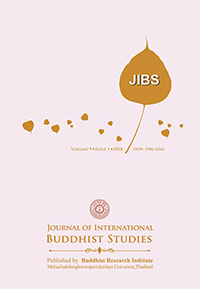The Dalai Lama’s Reinvention of Buddhism Supporting Religious Pluralism: The Middle Way between Traditionalism and Secularism
Keywords:
Dalai Lama, Buddhist Modernism, Religious Pluralism, Middle WayAbstract
The HH 14th Dalai Lama (HH) is one of the most influential Buddhist figures nowadays. My research will focus on the HH’s role in promoting religious pluralism in the contemporary period. Particularly, I will discuss how HH skillfully highlights some Buddhist doctrines to adapt contemporary audiences from different religious backgrounds. He strongly advocates that Buddhism is a pluralistic religion par excellence that is suited to the modern pluralistic society. I am aware that some authors have the same idea of mine that HH is promoting religious pluralism in modern society. Further elaborating on the authors’s idea that HH actively reimagines and portrays Buddhism as modern, I will argue that his presentation of Buddhism as a pluralistic religion can be analyzed as his attempt or “skillful means” to bridge and find the “middle way” between traditionalism and secularism for his contemporary audiences.
References
Batchelor, Stephen. (2012). A Secular Buddhism. Journal of Global Buddhism, Vol. 13, 87-107.
Compson, Jane. (Jun., 1996). The Dalai Lama and the World Religions: A False Friend? Religious Studies, Vol. 32, No. 2, 271-279.
Garfield, Jay L. Buddhism and Modernity. PhilPapers. Retrieved from https://philpapers.org/rec/GARBAM-3.
Gyatso, Tenzin. (2010, May 4). Many Faiths, One Truth. Retrieved from http://www.nytimes.com/2010/05/25/opinion/25gyatso.html.
______, The Fourteenth Dalai Lama His Holiness Tenzin. (2006). Kindness, Clarity and Insight. Ithaca: Snow Lion Publications.
Holiness The Dalai Lama, His. (1998). The Good Heart: A Buddhist Perspective on the Teachings of Jesus. Boston: Wisdom Publications.
______. (1999). Spiritual Advice for Buddhists and Christians. New Delhi: New Edition Publishing House.
______. (1999). Ethics for the New Millennium. New York: Riverhead Books.
Horner, I.B. (1963). The Book of Discipline (Vinaya Piṭaka) Volume V
(Cullavagga). London: Luzac and Company Ltd.
Jackson, Roger R. (2000). Buddhist Theology: Critical Reflections by
Contemporary Buddhist Scholars. Great Britain: Curzon Press. Kim, Kwang-Ki. (2003). Order and Agency in Modernity. Albany: State
University of New York Press.
Kubo, Tsunugari and Akira Yuyama. (2007). The Lotus Sutra. Berkeley: Numata Center for Buddhist Translation and Research.
Lopez, Donald S. (1998). The Prisoners of Shangri-La: Tibetan Buddhism and the West. Chicago: The University of Chicago Press.
Makransky, John J. (2000). Buddhist Theology: Critical Reflections by Contemporary Buddhist Scholars. Great Britain: Curzon Press.
McMahan, David L. (2008). The Making of Buddhist Modernism. Oxford: Oxford University Press.
Netland, Harold. (2001). Encountering Religious Pluralism: The Challenge to Christian Faith & Mission. USA: InterVarsity Press.
Ñāṇamoli, Bhikkhu and Bhikkhu Bodhi. (2001). The Middle Length Discourses of the Buddha: A Translation of the Majjhima Nikāya. Oxford: Pali Text Society.
Anon, (2018). Retrieved January 8, 2018 from https://www.dalailama.com/ videos/categories/teaching
______(2018). Retrieved January 8, 2018 from https://www.dalailama.com/ schedule/2016-archive







